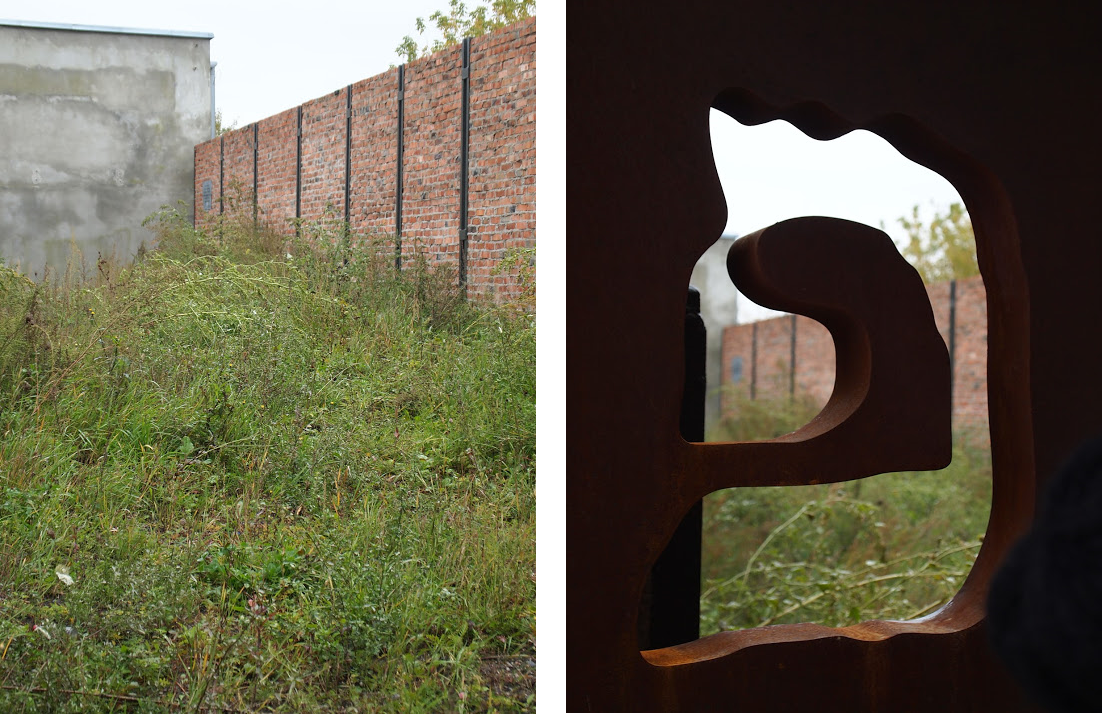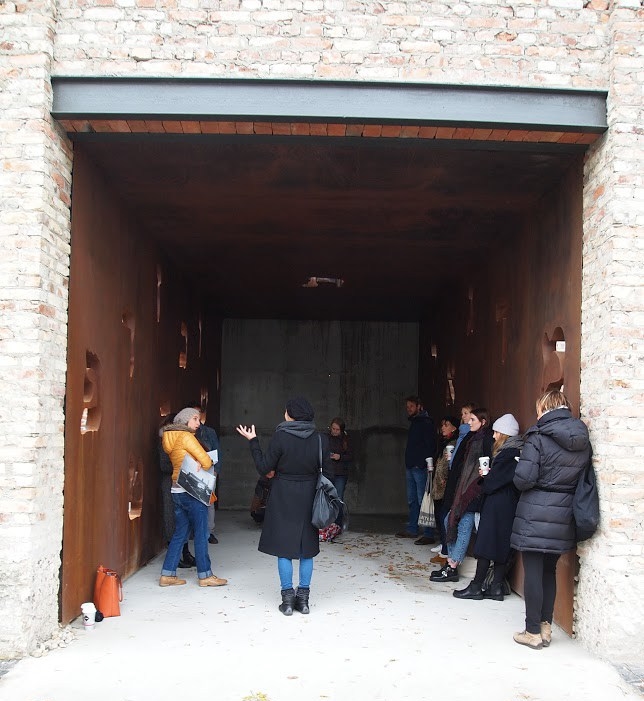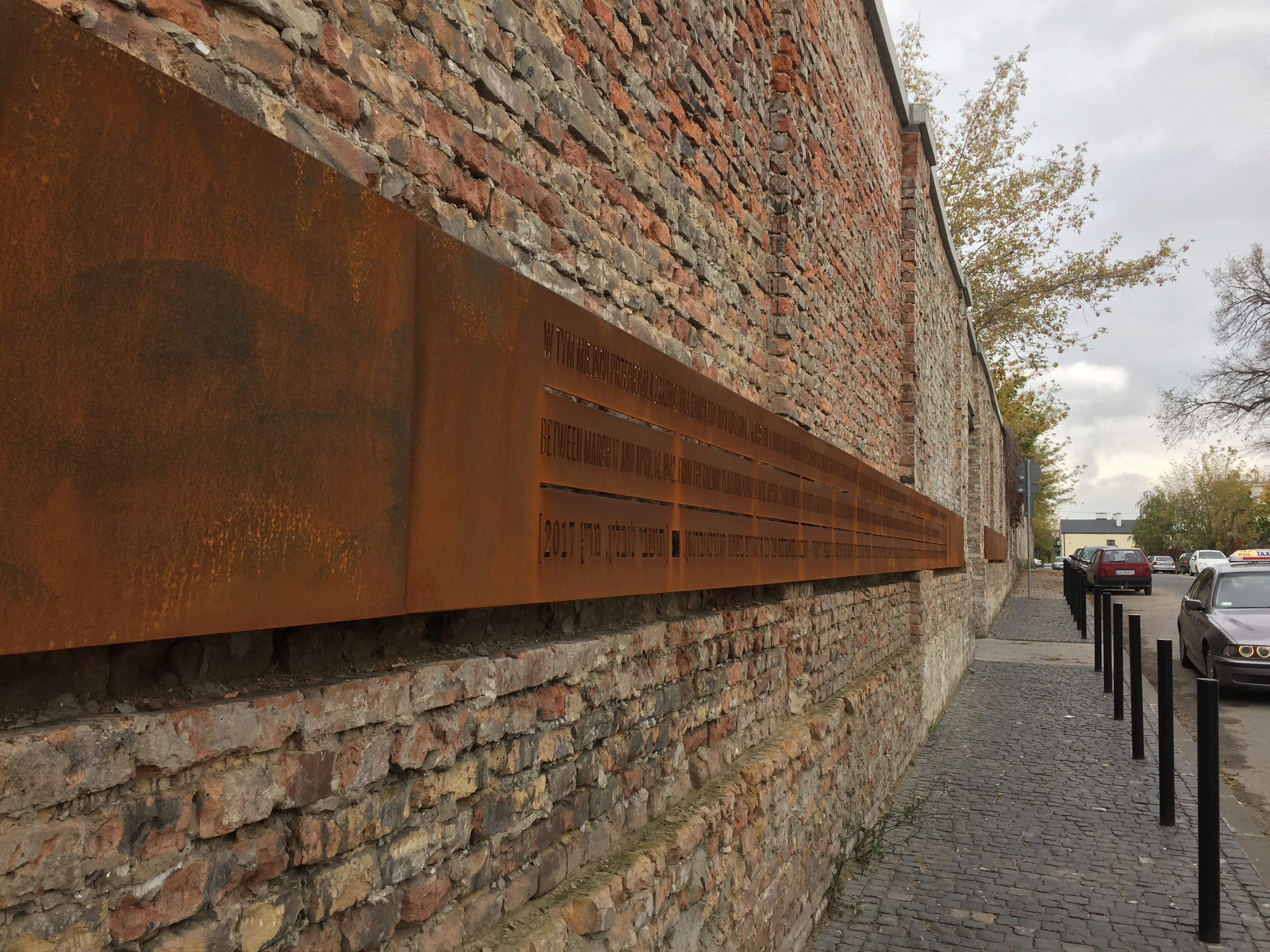By Elspeth Hunter
The woman at the bus station told me there were no busses that passed through this area – instead she forced a leaflet on Majdanek into my hand and pointed me to the door, as if by natural reflex. The ‘Umschlagplatz’ on Zimna Street, Lublin, was obviously a mysterious place to most Lubliners; even the tourist information office had no recollection of the memorial that has been erected there this year – an ongoing project initiated by the Grodzka Gate in 2008, a local cultural centre whos mission is to draw out “the symbolic and historical significance” the gate itself – the historical passage linking the Jewish district and the Christian disctrict, and a self-proclaimed “meeting place of various cultures, traditions and religions.” [1] I hailed a taxi instead and began the journey towards the ‘Umschlagplatz’, the location of the rail tracks that in March 1942 would take 28,000 Jews of Lublin on their final journey to the death camp Belzec….
The journey wasn’t long – perhaps ten minutes at the most – but the familiar city-like surroundings had already morphed into what resembled a small industrial village on the outskirts of nowhere. I wondered if the driver had taken me to the correct place, with no signage to keep me at ease, until with a sudden foot on the brakes, we pulled up directly in front of the installation – an inconspicuous crate structure hidden away in a small opening in the wall of what used to be a working slaughterhouse, founded in the 1920s and used throughout the war. The remote location of the site explained a lot – situated outside of the centre, you’d have to be a dedicated tourist, or rather a pilgrim, to take the time to see the installation I assumed. Such “death marches” as the Memory Trail, ending at the ‘Umschlagplatz’ installation, are “not only an act of repentance,” showing physical remorse for the horrors of the Holocaust. [2] Tim Cole believes these marches can also act on a different level as “support for…the Jewish state” in a particularly anti-semitic climate – the act of retracing these steps is more than just commemoration but also active advocacy of the founding of the State of Israel and counter-action against anti-semitic discourses. [3] At first, this was my initial perception of the site and its potential visitor group, as I aligned the site with the marches I had read about in Cole’s texts.
I had hoped that my visit would entail some thrilling investigative exploration in and around the site – a full access site-analysis to really get to grips with the history and the recent installation. But instead, to my dismay, I felt restricted and stifled; surrounded by either brick walls, or overgrown grassland, visitors are only allowed visual and physical access to a small portion of the site itself – even the original railway line that was used in 1942 is hidden behind the impenetrable walls. Once inside the carriage-like construction, my eye was drawn to the small perforated windows in the walls – accordingly in the shape of Hebrew letters. Underwhelmed, the windows led my gaze out onto what seemed to be a small, unkempt garden. Allowing only a glimpse of the looming structure of what used to be the old slaughterhouse behind simply worked to whet my appetite – if I could describe my overriding feeling at this site, it was intrigue; what is hiding behind these walls? Aside from this, memories of other Holocaust sites were brought to the fore as I began to think about how other visitors may react. The experience began to feel increasingly tailored towards the typical “Holocaust tourist;” [4] indeed, despite being erected as an art installation, as designed by the artist Karol Badyna as part of the 2008 competition held by the Grodzka Gate, the ‘Mis/Remembrance of the Place’ installation undeniably models itself on the typical Holocaust monument aesthetic. The rusty metal walls that bleed when the rain pours combined with the austere concrete floor are motifs used in many Holocaust memorials – take for instance the bleeding iron letters and the Contemplation room at Belzec, or the towering oxidised memorial in Bologna – just two examples of this current trend. Without any obvious direction, and by positioning itself within the broader discourse of Holocaust memorialisation, the ‘Umschlagplatz’ subliminally instructs visitors on how to act and use the site by visually evoking memories of other such sites.

Moreover, it became clear that the materials used had a dual purpose; in that moment I felt a sense that the dank and bleak conditions within the cart were meant to resemble the conditions that the Jewish population of Lublin was subjected to during Action Reinhardt, as well as their sentiment. The rusting iron and cement used also mimic common materials found in a derelict site of a disused building – the feeling of abandonment is rife here, as the walls seem to have aged at a rapid pace, adding to the sensation of neglect and time-gone-by. In a twisted way, the use of these fabrics felt like a dramatic tool of dark-tourism, a ploy to haunt, as if the artist wanted the visitor to experience the horrors of the Holocaust – obviously an impossible mission.

So far, I had experienced two clashing narratives which struggled to sit comfortably side by side – it felt wrong to be confronted with such a typical looking monument, which sent a chill down one’s spine, at the end of what could be conceived as a pilgrimage to a remote part of Lublin, the journey and action of retracing the steps of the Lublin Jews perhaps requiring a higher level of dedication and reason than your typical ‘Holocaust tourist’. I felt these more dedicated and involved visitors deserved more than Badyna’s installation. With all these observations in mind, the question of who the site is for and who actively uses the site becomes even more confusing.
Another revelation added to the confusion. Speaking to Joanna Krauze of Rootkatours, a local organisation which arranges bespoke Jewish heritage tours around Lublin, I was made aware of the change in ‘Jewish tourism’ within the region. Asking for more personalised experiences, Krauze highlighted the recent demand for information on the daily lives of Jewish family members and spoke of a definite move away from Holocaust histories. As such, the Jewish tourists who are travelling to Lublin are no longer solely interested in the Holocaust narrative, and in many instances have no desire to visit the ‘Umschlagplatz’ with its unpleasant history at all.

So is the installation serving a purely commemorative role? This too I had to discount, due to the fact that the installation is arguably a performative piece. Peering through the perforated walls out onto the grassy wasteland offered a third narrative, and took my thoughts in a new direction, particularly when we consider the current political context within Poland at large. The performative action of looking through the windows out on the derelict grasslands beyond symbolised the very action of retrospectively looking back on history and the passing of time – the untouched nature around the carriage representing the years passed since the Holocaust. Drawing on the works of Dylan Trigg, we begin to “fill out the broken form” of the ruinous state of the environment outside the windows when it is framed and offered to us in such a way. [5] The passing of time, or more appropriate, the forgetting of passed time, is important here and can be interpreted as the artist alluding to the silence which dominated the years after the Holocaust surrounding the Polish involvement with the Nazi forces.
Referencing this silence is topical today as despite the brief period of openness that came with independence from the Soviet Union in 1989, Polish society has in recent years become increasingly more nationalistic, particularly when it comes to the collective memory of the Holocaust. Statistics revealed by Sławomir Kapralski suggest that:
“In 1992 46 percent of Poles believed that Jews suffered more than Poles in the years of World War II, in 2002 only 38 percent held such an opinion….the answer most frequently given in 2002 was the both Poles and Jews suffered equally: 47 percent were of that opinion, compared to 32 percent in 1992…” [6]
This shift in public opinion on Holocaust victimhood is reflected in the current political atmosphere within Poland; in 2015, the nationalistic right-wing Prawo i Sprawiedliwość (PiS), Law and Justice Party, gained a momentous victory, winning a 37.5% majority in the national parliamentary elections, an achievement that had not been seen since the fall of communism within the country. [7] As discussed by Molly O’Neal, the party “aims to change how Poles define their nation,” [8] using a “strictly Polish” model – one which glorifies a “hagiographic version of Polish history.” [9] Indeed, their strong emphasis on revising the historical national narrative has the ultimate goal of “educating the youth in a ‘correct and patriotic’ fashion,” [10] and to strengthen confidence in the notion of an independent Polish state during an era of euroscepticism. One of the ways the PiS party are attempting to revise their national narrative is by assuming complete management of the Institute of National Remembrance (IPN), the most influential centre of research in the country, enabling the party to dictate the direction of future research and cultural enterprise. [11] Moreover, even the use of suggestive language is now a crime in the country; the Polish Prime Minister Beata Szydlo approved a bill in August, 2016, which criminalises the phrase “Polish death camps,” punishment for doing so resulting in a three year jail term. [12] Deemed offensive to the Polish nation, the term “Polish death camps” implies not just complicity, but the direct involvement and instigative actions of Polish citizens in the heinous crimes of the German Nazi forces. Considering the Polish legacy of silence surrounding their involvement in the Holocaust, and the adopted mentality that Poles had no part to play in the murder of Jews, this suggestive term is considered deeply offensive by many.
Specifically within the region of Lublin, ten out of fifteen seats were won by PiS party members, a sure sign of their popularity within the area and the strong right-wing sentiment that characterises the east of Poland at large. Prior to the installation being erected, Dariusz Jezior, a Law and Justice councilor, commented on the way in which people referred to the site, announcing that the use of the term ‘Lublin Umschlagplatz’ “provokes a number of unfavourable associations, false and even strikes my dignity as a resident of Lublin.” [13] Evidently, highlighting and commemorating the site alone becomes problematic for supporters or members of the PiS party, as it unavoidably brings about discussions specifically on the Holocaust, rather than Polish victimhood and World War II.
The piece perhaps works conceptually in defiance against the backdrop of the current political climate – it asks the Polish population to look back on history, particularly the legacy of silence and their growing belief in Polish victimhood, in order to prevent this so-called “historical whitewashing.” [14] Typically, remembrance of the Jewish presence within Polish memoryscapes has taken the form of romanticised nostalgia – a “vision of a colorful, “multicultural” past” – one that mostly “glosses over” anti-semitism. [15] Here, as with much of the work conducted by the Grodzka Gate, the focus is predominantly on the anti-Semitism inherent within Polish society, both currently and historically, leading me to assume that the intended audience of the installation is indeed the non-Jewish Polish audience, in a bid to encourage critical retrospective awareness of the national identity.
However, the site could potentially have this effect if it were to actually involve members of the Polish community in a practical manner, rather than relying on its abstract meaning to do the work. Diana Popescu recently commented on the actions of the Grodzka Gate, writing that their projects usually “focus on reconciliatory aspects,” and aim to “bring people together into a commonly shared commemorative space.” [16] Whilst this can be witnessed in many of their other projects, such as One Land – Two Temples, and Salvaged Stories, which have a strong focus on participation and activity, the ‘Mis/Remembrance of the Place’ lacks this ‘shared experience’. Unfortunately, it is this notion of ‘shared experience’ that could have given the ‘Umschlagplatz’ memorialisation purpose, keeping it active and constantly working in the favour of peace and reconciliation, rather than conceptually inaccessible to much of the Polish population. Given the circumstances – that the site is relatively far away from the town centre, that many jewish tourists who might traditionally visit the site no longer want to experience Holocaust narratives, that many Polish citizens do not show independent interest in visiting sites of Jewish history particularly in the current political climate – surely a community project which involved individuals at every stage of development, allowing them to feel a sense of responsibility and ownership of the site, would have been the most beneficial form of project? In its current state, the installation struggles to find a practical role in the community – for both locals and tourists – and given the current path Polish politics is taking, the future of the site remains uncertain.
[1] ‘History of the “Grodzka Gate – NN Theatre” Centre,’ About Us, Grodzka Gate, accessed 17th November 2017, http://teatrnn.pl/about-us/
[2] Cole, Tim, ‘Holocaust Roadscapes: Retracing the “death marches” in contemporary Europe,’ in Cahiers de Geographie du Quebec, vol 57, no. 162, (2013), pp. 445-459, p. 454.
[3] Ibid., p. 454.
[4] Ibid., p. 447.
[5] Trigg, Dylan, ‘The Place of Trauma: Memory, Haunting, and the Temporality of Ruins,’ in Memory Studies, 2:1 (2009): 87-101, p. 88.
[6] Kapralski, Sławomir, ‘(Mis)representations of the Jewish Past in Poland’s Memoryscapes: Nationalism, Religion and Political Economies of Commemoration,’ in Curating Difficult Knowledge: Violent Pasts in Public Places, edited by Monica Patterson, Cynthia E. Milton, and Erica T. Lehrer, Hampshire: Palgrave Macmillan, 2011, pp. 179 – 192, p. 183.
[7] Krzyżanowski, Michał, ‘Discursive Shifts in Ethno-Nationalist Politics: On Politicization and Mediatization of the “Refugee Crisis” in Poland,’ Journal of Immigrant & Refugee Studies, 16 (2017), p. 7.
[8] O’Neal, Molly, ‘The European ‘Other’ in Poland’s Conservative Identity Project,’ in The International Spectator, 52:1 (2017), 28-45, p. 28.
[9] Ibid., p. 29.
[10] Junes, Tom, ‘The rise of ‘youth nationalism’ in Poland’, openDemocracy, 26th July 2016, accessed 31st October 2017, https://www.opendemocracy.net/can-europe-make-it/tom-junes/rise-of-youth-nationalism-in-poland
[11] Ibid.
[12] Borschel-Dan, Amanda, ‘Is the new Polish law an attempt to whitewash its citizens’ role in the Holocaust?’ Times of Israel, 18th August 2016, accessed on 31st October 2017, https://www.timesofisrael.com/is-new-polish-law-an-attempt-to-whitewash-its-citizens-roles-in-the-holocaust/
[13] Smaga, Dominik, ‘Wymordowano jedną trzecią miasta. Tak będzie wyglądać Umschlagplatz w Lublinie,’ Dziennik Wschodni, November 19th, 2016, (translation useing Google Translate) retrieved from, http://www.dziennikwschodni.pl/lublin/wymordowano-jedna-trzecia-miasta-tak-bedzie-wygladac-umschlagplatz-w-lublinie,n,1000190007.html
[14] Borschel-Dan, 2016.
[15] Kapralski, 2011, p. 183.
[16] Popescu, Diana I., ‘Performative Environments of Polish Memory: The Grodzka Gate – NN Theater Center’s Approach to Lublin’s Jewish Pasts,’ in Dapim: Studies on the Holocaust, 31:2 (2017), 111-130, p. 129.
